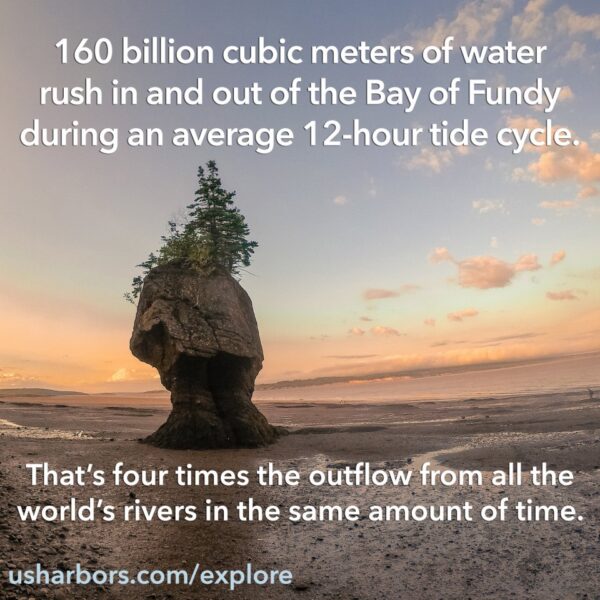Tides are the rising and falling of ocean levels and are caused by the sun and moon’s gravitational pull combined with the rotation of the earth. The moon’s gravity is pulling the water up, while the earth’s gravity is pulling the water down.

High tide occurs when the wave’s highest part reaches a specific location and low tide occurs when the wave’s lowest part reaches that specific location. A tide cycle can occur once or twice a day depending on the area and its proximity to the moon.
A tide cycle consists of the sea level rising until high tide is reached, then the sea level falling until low tide is reached. Then the cycle begins again.
Interesting Tide Facts:
- The theory that tides were caused by the moon was introduced in 150 BC by Seleucus of Seleucia. Isaac Newton (1643-1727) was the first to explain tides with gravity related to the sun, earth, and moon.
- The Moon is the most relevant factor in the creation of tides. The sun’s gravitational force on the Earth is only 46 percent that of the Moon;
- The tide is a very large, very long wave that travels around the world at 450 miles per hour. It has no beginning and no end. The 12-hour gradual rise and fall we see on the beach is the wave’s passing, first its crest and then its trough. The tidal cycle is 24 hours and 50 minutes;
- Tidal range is the difference between low and the high tide. Some regions of the world have a larger tidal range than others because of the differences in the shape of the ocean floor. In the Bay of Fundy, the tidal range is about 16 metres. In the Caribbean Sea, the tidal range is between 10 and 20 centimeters;
- The Panama Canal has locks to raise and lower ships in transit from the Atlantic and Pacific oceans because of the difference in tide range and timing on both coasts. Only in February are the tides about the same on the Pacific side and Atlantic side;
- The shape of the shoreline, bays, estuaries, local winds, and weather patterns can affect tides, although to a lesser extent than gravitational pull. Nearly enclosed seas reach deeply into continents and are connected with the open ocean by narrow waterways called straits. Seas of this type include the Mediterranean Sea and the Baltic Sea. Because such seas are almost landlocked, they have a small range of tides. Some have no tides at all;
- Diurnal tides are the most common type of tide and occur when there is only one high and low tide per day. Semidiurnal tides occur twice a day with two highs and two lows. In Ireland we mostly experience two high tides and two low tides each day. The time at which the high and low tide occur will change day to day. In Pondicherry (India) and in certain ports of Vietnam there is only one tide per day;
- Spring tides (larger tides) happen when the new moon and full moon phase is occurring. When this happens the moon is on the same side of the earth as the sun;
- Neap tides (weaker tides) happen when the moon is in its first quarter or last quarter phase. When this happens the moon is at a right angle to the earth-sun line;
- The world’s highest tides can be found in Canada at the Bay of Fundy in the province of Nova Scotia, here they can reach up to 18.5 metres;
- In France there is a 15 metre tidal range in the bay of Mont-Saint-Michel in Normandy. Here it is traditionally said that “the sea rises at the speed of a galloping horse” and then surrounds Mont Saint-Michel.
- While tides never exactly repeat themselves, due to a repeat in the cycle of the Sun and Moon every 19 years tide charts come closest to repeating themselves every 18.6 years;
- Even around a small country like ireland there are big variations in tide times. As the Earth rotates, the water has to move to generate the high tides but because of the shape of coastlines and the variation in sea depth (bathymetry), there is a lag. Every location has a unique coastline and bathymetry – which gives each location its unique tidal pattern.
The Marine Institute have compiled a fun worksheet for families to complete at home which you can download here: Learning about the Tides – A Fun Tidal Quiz & Worksheet
References:


